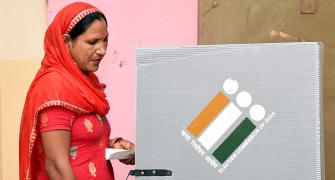In the euphoria of being a "young" India with oft-quoted demographic statistics that half of India is below 25 years of age and two-thirds are below 35, it is easy to ignore the fact that India is also home to a very large number of aged in absolute terms and that by 2027, it will have over 170 million people above 60 years of age, almost double of what we have today.
India's endemic infrastructural deficiencies are now glaringly visible beyond the top 8 metros and mini metros. Roads, public transport, potable water, power, affordable mass housing, ports and airports and the railway network -- all are stretched beyond their originally planned capacity and will, unfortunately, end up creating a huge drag on the economic growth in the coming years.
However, these deficiencies pale in comparison with those in the social infrastructure. With almost 25 million births per year, India needs an annual incremental addition of education as well as healthcare facilities equivalent to almost half of what a UK or a France or an Italy may need for their entire populations.
This addition does not even take into consideration the backlog we have built up over the last few decades on account of not ramping up spending on education and healthcare in line with the increase of population and the changes in the overall socio-economic environment.
We in India have gladly accepted the membership to the BRIC club, and rejoice every year when Forbes publishes its annual list of the super wealthy. What is not easily appreciated is the fact that on every social indicator, India is still more a third-world rather than an emerging economy. Sticking to the theme of this particular piece, I would focus only on the healthcare indicators.
Against a world average of 3.96 hospital beds per 1,000 population, Russia has 9.7, Brazil has 2.6, China has 2.2, and India languishes at just over 0.7. The deficiency is appalling on a similar scale when one compares the norms versus the actual for doctors and nurses.
Worse, while it is theoretically possible to create a million or more new beds (just to bring the availability of the beds to 1.7 per thousand from the current levels) in an accelerated manner by large-scale financial investment (about $80 billion or Rs 320,000 crore (Rs 3,200 billion) taking the cost per bed at a conservative $75,000 or Rs 30 lakh (Rs 3 million) against current costs of new players like Max and Fortis and Apollo that are well in excess of Rs 50 lakh per bed, and in the US, where the cost is reportedly now running at $2 million per bed), it is not possible to accelerate the development of trained doctors and nurses and other technicians.
India currently has about 600,000 doctors and about 1.6 million nurses. As per WHO norms for developing countries, this translates into a shortfall of 1.4 million and 2.8 million doctors and nurses, respectively, for India. With a total current annual output of about 22,000 doctors, one can only imagine the lamentable gap between the educational capacity in this sector versus the requirements.
Sadly, this still does not complete the picture. On account of urbanisation and changes in the overall lifestyle of the population, India is already seeing alarming growth in the so-called lifestyle diseases. Projections are that in the 2005-2015 decade, the incidence of heart disease will increase by 68 per cent, diabetes by 48 per cent, and cancer by 40 per cent. The economic cost to the nation in the next decade could be as much as $236 billion on account of cardiac diseases and diabetes alone.
Reaching developed country healthcare norms by 2027 will require an astronomical $1,000 billion over the next 20 years. Even reaching halfway (i.e. the current norms of China and Brazil in terms of the number of beds) will entail an investment of over $500 billion, i.e. between $10 billion and $20 billion per year for the next 20 consecutive years.
Unfortunately, unlike other sectors, healthcare delivery cannot be priced on a cost plus basis since the payee's ability in India is severely constrained with practically negligible penetration of healthcare insurance. It is no surprise, therefore, that almost all of the current organised healthcare service providers are struggling to show any profitability at all despite carrying the tag of being "premium". In these circumstances, it is very difficult to imagine fresh capital formation of this magnitude anytime in the near future since generating adequate returns on investment under current healthcare sector dynamics is a huge challenge.
India can probably live for a few more decades with potholed roads, erratic power supply, cramped airports and a filthy railway network, and skyrocketing commercial and residential capital values. With 25 million new- borns and a net addition of almost 18 million per year to the 1.15 billion already to take care of, can we live with endemic illiteracy (or inadequate literacy) and inaccessible or unaffordable healthcare for hundreds of millions? In the shadow of these hard facts, the Sensex at 20,000 and Forbes listing showing an addition of 20 or more billionaires from India may look a bit less impressive!








